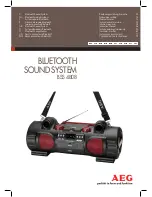
Townsend Labs Sphere L22 Precision Microphone System Guide
Recording Acoustic Guitar
43
Guitar with Vocals
Two Mics
For a guitarist who sings, it is often desirable to record the guitar and vocal at the same time to
capture alive performance, instead of relying on overdubs. Typically accomplished using separate
mics for the vocal and guitar, this technique can work well but you must consider bleed from the off-
axis sources. The bleed will generally be out of phase with the on-axis sound, so comb-filtering will
result when the two tracks are mixed together. Even if the mics are aligned well enough to prevent
comb-filtering, the high frequency response will likely be compromised due to very small differences
in distance. Since sound at 20 kHz has a wavelength less than 2 cm, just a difference in path length of
a few millimeters can noticeably affect the high frequency response. In most cases, it is impractical to
align mics with that degree of accuracy.
All of these issues are further complicated when EQ, compression, and other processing is added to
the individual tracks. Equalizing the guitar track also applies that EQ to the bleed from the vocal, and
vice versa. Therefore, it’s often not possible to find EQ settings that work well for both the vocal and
the guitar. Compression generally increases the level of the bleed relative to the primary source,
which can also exacerbate phase issues.
Cardioid mics are often used in this application for their directionality, but bleed can still be a
problem: at 90° off-axis, the level is only 6 dB down. Another common approach uses a mic with a
figure-8 pattern, such as a ribbon or multi-pattern condenser, because the response at 90° off-axis is
close to zero. This allows placing the acoustic guitar in the null of the vocal mic, while still getting
good direct vocal pickup. The guitar mic is pointed directly at the guitar but oriented to reject the
vocal. With proper placement, this can produce an incredible amount of isolation between the guitar
and vocal, so you hear just reverb from the off-axis source, with virtually no dry signal.
Figure 7-1 shows this technique in action. The vocal mic is on top with a polar pattern shown by the
blue figure-8, and the guitar mic is below with a polar pattern shown by the magenta figure-8. Each
mic is positioned to reject the other’s sound.
Figure 7-1
Recording acoustic guitar and vocals with two mics
Содержание Sphere L22
Страница 1: ...Precision Microphone System Hardware and Software Guide Version 161003 ...
Страница 2: ......












































